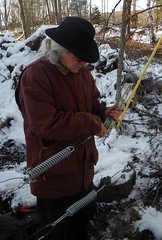 We got the pigs 100% behind hi-tensile today. It’s supposed to snow again Wednesday and that would have been the end of the electronet.
We got the pigs 100% behind hi-tensile today. It’s supposed to snow again Wednesday and that would have been the end of the electronet.
So, instead of using grounded electronet, I’m trying to use ground rods. Guess what. It doesn’t work. This is the same set up I tried to use 4 years ago and it didn’t work then either. I have a modest fencer with two 6 ft rods, ten feet apart, which is what the fm says. And a fence tester says the ground rod has 2.4 Kv to actual dirt. And no it’s not my lousy connections: One probe in the dirt, one probe on the actual rod, 2.4 Kv.
So I asked farmer Google. Ground rods actually suck. I found a kiwi recommending three ten ft (3m) rods 10 meters (33ft) apart, in a wet spot, as a minimum. Sheesh.
I have some serious issues with this technology. Why does the ground connection along the base of a roll of electronet work? Yes it’s a lot of spikes. Three inches long.The conductor is lying on _grass_, 90% not touching dirt. But that actually grounds.
Second, I made my living in Electrical Engineering for 17 years. For every one of those years, and years of coursework before, when I put two equal resistors in parallel, the voltage drop was halved. When I hooked up the second ground rod today, the voltage went from 2.4 kv to 2.1 kv.
Anyway, I should still be able to pound in a couple of posts tomorrow.
hi Lisa
I like this, finished farm chores, sit down with mid-morning tea and read what Lisa is up to.. its fun!
Val (from Canada with the ISD’s)
Frank, I’m an amateur electrician, no EE, but I’ve run into this before. We have horrible ground issues here at the house and a ground rod that only occasionally does squat. (And it’s illegal to ground onto water pipes in MA, even if you make sure to jump the meter.) It seems like AMOUNT of earth contact, especially on/in cold soil, is more important than how deep you sink the rod – which is why your net, with a whole lot of very shallow/casual contact with the ground, is more reliable than your rod contacting deep but at only one point. How hard would it be to sink many shallow grounds along the fence?
Also, I believe in the immutable law that voltage gets divided by parallel resistance as well, but that assumes perfect transmission in the circuit.
🙂
I put in three more ground rods today, an average of three feet down before they hit ledge. That brought the ground rod to ground voltage down to 1.5kv. It did not however change the voltage from wire to ground. Then I added a T post to pull the wire off a snowy rock. Suddenly I had 7kv from the wire to ground. Looks good, but I fear there would still only be 2kv through a pig or a horse. Sheep are high impedance so I may have done some good there.
I didn’t think the spikes on the electronet contributed to the ground, but I could be wrong (it’s happened before!). Regardless, I think Columbine is onto something. I remember reading on a farm list somewhere something similar and the poster said they solved their problem by using a piece of galvanized roofing as their ground, rather than ground rods. They didn’t even have to bury it very deep. All that surface area in contact with the dirt did the trick for them.